
|
|
article: A Mid-Century Modern Composer's Home in Woodbury, Connecticut.pdf
41.539436 N, -73.235878 W
Design |
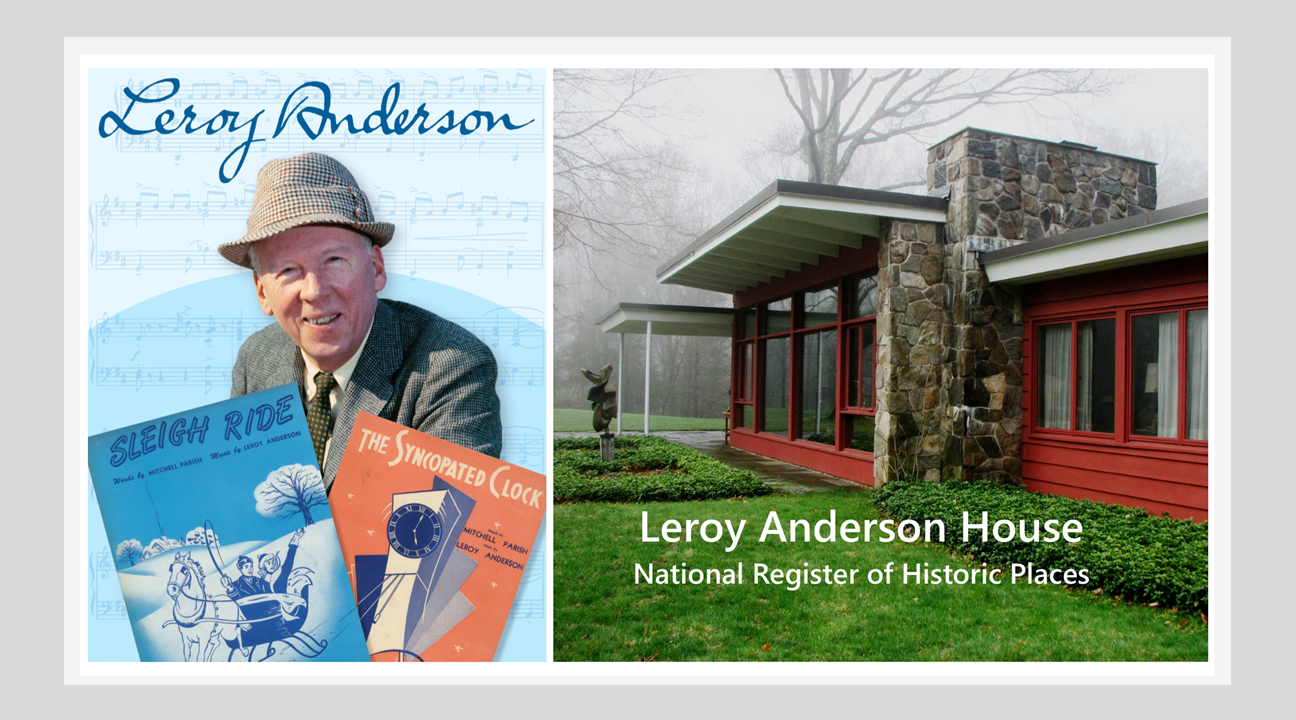 A Historic House Museum On the National Register of Historic Places  |
Updated December 11, 2025
The Leroy Anderson House is a historic house museum in Woodbury, Litchfield County, Connecticut. The house was the home of American composer Leroy Anderson (1908 - 1975) and his wife Eleanor Firke Anderson (1918 - 2014). The Leroy Anderson House was named to the National Register of Historic Places on December 31, 2012. The Leroy Anderson House was designated a Historic house museum by the Town of Woodbury on March 27, 2018. The Leroy Anderson House is one of a small number of composers' homes in the United States occasionally open to the public. The Leroy Anderson House is also one of a small number of Mid-20th Century Modern Homes in New England occasionally open to the public. The Leroy Anderson House is a historically significant landmark of Swedish-American culture in the United States. It is the headquarters of the Leroy Anderson Foundation, Inc.
Google Maps: Leroy Anderson House, Woodbury, Connecticut |
OPEN DAYS Spring 2026The Leroy Anderson House will be open in March and April 2026 for tours by appointment only on select weekend days from Noon to 5pm. To schedule a tour, please send an email to leroyandersonfoundation@gmail.com |
The Design |
Leroy Anderson commissioned the architect Joseph Stein of Waterbury, Connecticut to design a modern house where Anderson, his wife Eleanor and their children could live and where the composer could work. The house was constructed (1953-1954) by the McGinn Company of Naugatuck, Connecticut. The house is a Mid-Century Modern residence and is the earliest example of Stein's residential house designs. The building features large expanses of glass, native stone in walls and floors, geometric massing, and a lack of ornamentation. The two-story house rests naturally into the gently sloping, eastern base of Grassy Hill with views of Woodbury to the east. The house presents a subtle and sophisticated architectural statement. While many modern homes in the U.S. were commissioned by people who were patrons of modern art and design, business executives with a connection to industry, the Leroy Anderson House is one of a relatively small number of modern homes that was commissioned by an artist, specifically one who had achieved international prominence.
The Architect |
Joseph Stein (1916-1977) graduated from Dartmouth College in 1938 with B.A. and was elected to Phi Beta Kappa. He received his master's degree in Architecture from the Harvard Graduate School of Design in 1941. At the time Harvard was the only American university to embrace the Modernist movement. Stein was influenced by Walter Gropius, who founded the Bauhaus School of Design in Dessau, Germany in 1919. Gropius immigrated to the USA in 1937 to become head of the architecture program at Harvard. Joe Stein was one of Gropius' first students at Harvard. Other architects of the Modernist movement who studied under Gropius included Marcel Breuer, Philip Johnson, Edward Larrabee Barnes, Eliot Noyes and John Johansen - all of whom designed homes in Connecticut during the same period.
The Setting |
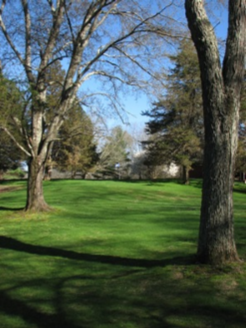
The Leroy Anderson House is set back from the south side of Grassy Hill Road on a 13.2-acre site which the Andersons purchased in 1952. When the Andersons built their house in 1953, Woodbury's population was just 2,500. There were numerous small dairy farms. The land just downhill of the where the Andersons built their house was used as pasture for cows that belonged to a farmer on a nearby road. From time to time the cows broke through the farmer's fence and grazed on the Anderson's lawn. The farmer would be summoned and would always make a rather temporary repair of the fence. The Andersons were not annoyed by the cows. Eleanor Anderson was born and raised in east-central Illinois and said that the cows reminded her of Illinois.
Looking East over the broad and gentle valley of lower Good Hill Brook, Transylvania Brook and the Pomperaug River towards the center of Woodbury, a distance of one mile, one could see Orenaug Rocks and Orenaug Park rising sharply over the buildings along Woodbury's Main Street. This was a dramatic view that has been partially lost to the return of many trees that grew after the farms were replaced by houses.
Sunrise and, in particular, moonrise as seen from the spacious living room or the terrace was often quite beautiful. The well-drained soil of the glacial moraine, a drumlin, on which the house sits, had been expertly landscaped by Oscar F. Warner company of Woodbury. Oscar Warner had a degree in Forestry from Yale University and owned a successful landscaping business in Woodbury. Warner had a large tree nursery near his house along the Pomperaug River from which he selected a variety of trees which he planted on the rolling two-acre lawn surrounding the Anderson house. American beech, Copper beech, Pin oak, Tulip, Honey Locust, Sugar maple, Red maple, Black maple (from Pennsylvania), Shagbark hickory, and Black walnut, complimented the native Red cedar (juniper), Gray birch, White oak, Red oak, Hemlock, White pine and wild apples of the area. Leroy was very interested in trees, while Eleanor knew a great deal about flowers. A forty-year member of the Pomperaug Valley Garden Club, Eleanor Anderson worked hard with several friends to enhance the wildflowers along the Botany Trail at Flanders Nature Center in Woodbury. She had numerous beds of perennial flowers around the Anderson home.
The wetland complex called Hesseky Meadow at the foot of Grassy Hill attracts ducks and geese which occasionally fly over the house on their approach to the wetland. This, along with numerous deer, wild turkey, the occasional bobcat and black bear, confirmed that the house was indeed in the country. Leroy and Eleanor Anderson enjoyed song birds very much. Leroy built handsome and functional bird houses and bird feeders and took great pleasure in seeing the birds who used them. Leroy enjoyed watching gray squirrels from the kitchen as they attempted and failed in comical ways to bypass the features Leroy had built into his feeders to deter the squirrels.
Grassy Hill rises steeply to a broad ridge to the west of the house. The top of Grassy Hill sits at about 1,000 feet in elevation and continues north through eastern Roxbury as "Good Hill" and "Painter Ridge" and towards the southern end of Washington. All through the 1950s and 60s, one could see the steeples of all five of Woodbury's churches along a one-mile stretch of Woodbury's Main Street to the East.
The House 1952 - 1975 |
|
Joseph Stein created a modified rectangular layout and a flat roof that accentuates the house's distinctly horizontal profile. The house is 3,000 square feet in size. The exterior is finished with red-painted cedar siding, and the primary elevations are notable for their clean, uncluttered lines and large expanses of glass. The main living spaces are arranged in an open floor plan at the east end of the house, while bedrooms are segregated in the western portion. The experience of approaching the house and progressing from the sheltered entryway, to the foyer with open staircase and wrought iron railing, to the living room with its high ceiling and dramatic easterly view is very satisfying. Leroy Anderson specified that he wanted to be able to play string quartets in the living room. Anderson formed the "Southwood Quartet" which performed for their own pleasure every Friday evening from September to May for 10 years. The acosutics of the space are superb. 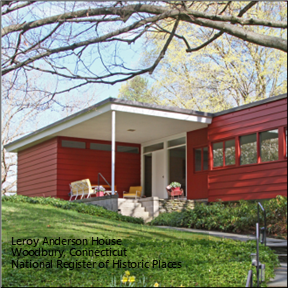 Photograph by Marc Russell Leroy Anderson was a thorough modernist. His Swedish heritage influenced his interest in Scandinavian design, food, and languages. Most of the furniture in the house is Danish Modern, designed by Arne Jacobsen, Hans Wegner, and Jens Risom. When Woodbury residents heard in 1952 that the composer had purchased land on Grassy Hill Road, they asked what type of home he planned to build. "A reproduction of a Colonial home," he said. He was afraid to cause any alarm even before starting the house. He never cared for old homes with their uneven and creaky floors and drafty walls. After the house was built, it seemed that people drove out to see the house as much for its nonconformity as for who lived there. Mr. Anderson used the room he called his "Work room" for orchestrating music. While he composed primarily in his head while walking very slowly through the house after supper, his work room is where he would score each composition. The room had been made soundproof with fully insulated interior walls. A very unusual feature is that there are two doors - one that opens in and one that opens out to a corridor. This was to keep other sounds from interfering with his thoughts. In a television program filmed at the house in the 1960s, the interviewer commented on the rural setting and asked if the house represented a splendid isolation. Anderson said: // In my youth I lived in a Brooklyn apartment and tried to write music while the girl upstairs took turns practicing voice and piano. I was never sure which of her musical aspirations was more frustrating to my work. Yes, I guess you could call it splendid isolation. It's the kind of place a composer needs.
" - Leroy Anderson, 1963
For Leroy Anderson the quiet of the rural setting was the critical element in the suitability of the house for composing music. // It is apparent that leisure and silence are absolute prerequisites for composers if they are to engage fully the many forms of awareness involved in creative activity. This leisure and silence have become the greatest luxuries in the modern world. Composers less than any other group in art or science are able to command it." - Peggy Glanville-Hicks, 1958
|
1975 - 2014 |
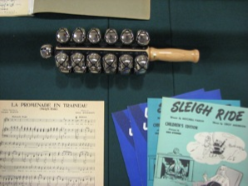
Following Anderson's death in 1975, his widow Eleanor Anderson set out to reinforce the public's awareness of not only her late husband's music, but of his personal story. To that end she engaged Peter Rosen to create the PBS biographical video about Leroy Anderson, she hired Burgess Speed to author the Greenwood Press bio-bibliography about him, and she organized the creation of an official website devoted to her husband's music and his life. She told her family and her friends that she wanted her home to become a house museum devoted to her husband.
In 2010 Eleanor Anderson formed the Leroy Anderson Foundation with the intention of leaving the house and surrounding land to the foundation. She created an exhibit within the house about Leroy and his music. This was enjoyed by numerous people who were socially acquainted with the Anderson family.
The Leroy Anderson House contains an exhibit devoted to Leroy Anderson. Visitors may see his Work room with Gold Record and original manuscripts, his Library with extensive collection of books on music and languages, the living room with grand piano, formal portrait by Isabelle Wadsworth, modern sculpture by William Talbot, modern painting reflecting Stravinsky's Firebird by Russell Huff commissioned by Leroy Anderson, Anderson's first composing desk that he built himself and his cello.
Significance |
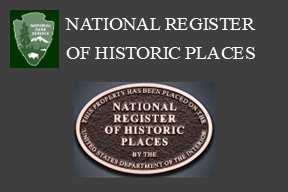
The Leroy Anderson House was named by the National Park Service (NPS) to the National Register of Historic Places on Dec. 31, 2012. The NPS Architectural category is Modern Movement. Of four possible acceptance criteria (significant event, significant person, significant example of architectural style, or source of historical information), the house was accepted on two criteria - (B) Person of prominence (Performing Arts) and (C) Architecture (Mid-century modern).
Composer - Person of Prominence |
Leroy Anderson was elected to the Songwriter's Hall of Fame. He has a Star on the Hollywood Walk of Fame. Leroy Anderson Square was dedicated by the mayor of Cambridge, Massachusetts. The Harvard University Band named the Leroy Anderson Band Center in the composer's honor. Harvard University named Leroy Anderson as a Notable Harvard Military Veteran. The National Counter Intelligence Corps Association has named Leroy Anderson as a Notable CIC Agent for his service in the US Army Counter Intelligence Corps in Iceland and in the Department of Military Intelligence at the Pentagon during World War 2. The United States National Archives at St. Louis, Missouri has designated Leroy Anderson as a Person of Exceptional Prominence, defined as a "historically significant individual",
Anderson's music owes its enduring success to his inexhaustible melodic imagination, the clarity and inventiveness of his orchestration, and his unique brand of musical humor. His centenary was marked by concerts and exhibits in America and around the world.
House - Architecture |
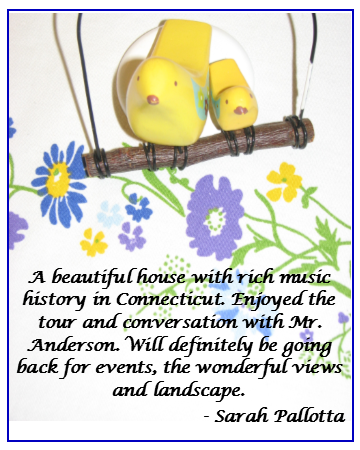
The Leroy Anderson House is the first Mid-Century Modern residence designed by Joseph Stein, who was one of the earliest students of Walter Gropius, noted professor of the ground-breaking Graduate School of Modern Design at Harvard University. The house is unchanged from when it was built and retains most of its original Scandinavian Modern furniture. Seventy years after its' construction, the Leroy and Eleanor Anderson House remains a significant part of the nation's cultural heritage.
While many European composers' homes have become house museums, few American composers' homes have been preserved in similar manner. Eleanor Anderson was keenly aware of this fact and was determined that the Leroy Anderson House be maintained in its original condition and become a house museum, similar to the homes of Aaron Copland, Stephen Foster, Howard Hanson, Charles Ives, Scott Joplin, Cole Porter, John Philip Souza, and Meredith Willson.
Visit the Leroy Anderson House |
OPEN DAYS Spring 2026The Leroy Anderson House will open in Spring 2026 for tours by appointment only on weekends from Noon to 5pm. To schedule a tour, please send an email to leroyandersonfoundation@gmail.com |
Concerts at the Leroy Anderson House |
Since September 2018 the Leroy Anderson House has presented free concerts for the public to enjoy. Performers have included pianist Yulia Fedorov, violist Rita Porfiris, violinist Anton Miller, pianist Susan Anthony-Klein, soprano Rebecca Nesmith, clarinetist Daniel Williams, flautist Jennifer Anthony-Bogue, cellist Joseph Darcourt, clarinetist Ivan Morozov, pianist Luis Ortiz, pianist Takeshi Nagayasu, pianist Cynthia Bos, violinist Zander Bos, violist Dylan Lomangino, violinist Mike Winer, violinist Mai Vestergaard, cellist Kai Vestergaard, violinist Selah Kwak, cellist Kaila Piscitelli, guitarist Mark Davis, and guitarist Beverly Davis, Imperial Brass Band, violinist Riana Heath, pianist Ilan Zagtman, clarinetist Adella Carlson, Candlewood Brass Quintet, Fanfare Brass Quintet, flautist Jaclyn Breeze and classical guitarist Daniel Corr.
For details about past and future concerts, see the page: News - Concerts, Music at the Leroy Anderson House
Friends of the Leroy Anderson Foundation |
Become a Friend of the Leroy Anderson Foundation Donate Volunteer |
Please enroll me as a Friend of the Leroy Anderson Foundation Make your check for $25 payable to the Leroy Anderson Foundation and mail it to: Leroy Anderson Foundation We will send you an acknowledgement of your donation identifying you as a Friend of the Leroy Anderson Foundation. Thank you ! Open a pdf file of the Friends Memebership Form - print and mail it in with your donation. |
Bibliography
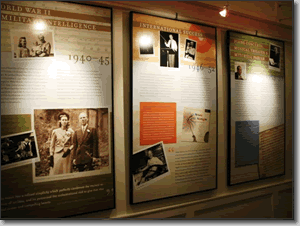
|
Categories 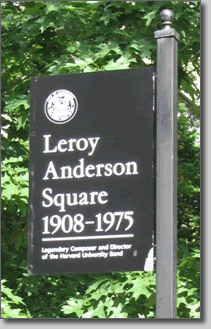
|
|
References
|
|
Links 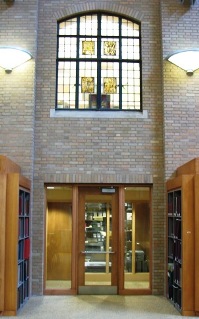
|